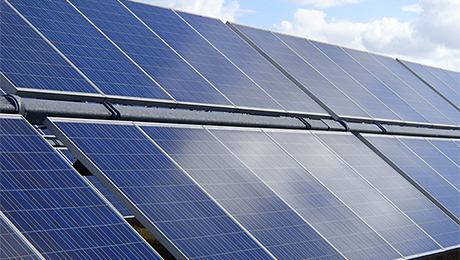The George Washington University, American University (AU) and the George Washington University Hospital (GWUH) announced Tuesday that they will create a renewable energy project that taps into solar power from North Carolina to meet a significant portion of their energy needs and reduce their carbon footprints.
Duke Energy Renewables will supply 52 megawatts (MW) of solar photovoltaic (PV) power, which is solar energy that is converted to electricity. This is the equivalent of the amount of electricity used in 8,200 homes every year.
“Thanks to this innovative partnership, the George Washington University will now derive more than half of all its electricity from solar energy,” said GW President Steven Knapp. “This will greatly accelerate our progress toward the carbon neutrality target we had earlier set for 2025.”
The partnership, dubbed the Capital Partners Solar Project, marks the largest non-utility solar PV power purchase in the U.S. and the largest PV project east of the Mississippi River.
The project, facilitated by CustomerFirst Renewables (CFR), will help GW and AU meet their climate action plan commitments without incurring additional costs. The partners will break ground on the first site this summer.
Solar power generated at panel sites in North Carolina will move through a North Carolina electrical grid into the D.C. regional grid, increasing the amount of solar energy in the region. Panels will begin to deliver electricity by the end of the year.
When fully operational at the end of 2015, the Capital Partners Solar Project will generate 123 million kilowatt hours (kWh) of emissions-free electricity per year, drawn from 243,000 solar panels at three sites. The total annual use of solar PV power translates to eliminating nearly 60,000 metric tons of carbon dioxide per year, the equivalent of taking 12,500 cars off the road.
“American University is firmly on its way to achieving carbon neutrality by 2020,” said AU President Neil Kerwin. “We are home to the largest combined solar array in the District and are resolved to growing green power through our purchase of renewable energy certificates.”
Once the project is complete, GW will receive roughly 86.6 million kWh, AU will receive 30 million kWh and GWUH will receive approximately 6.3 million kWh annually. The solar power will fuel more than half of GW’s and AU’s electricity needs and more than a third of GWUH’s need.
“We have a responsibility outside our four walls to the world beyond,” said Barry Wolfman, CEO and managing director of GWUH, adding that joining this partnership to embrace solar power reflects the hospital’s daily work as health advocates, caring, healing, teaching and birthing new generations.
Duke Energy Renewables President Greg Wolf said he looks forward to providing solar energy at a stable price to GW, AU and GWUH. The 20-year agreement will provide the partners with fixed pricing for solar energy at a lower total price than current power solutions. It is also expected to yield future savings for the partners, as traditional power prices are anticipated to increase at a higher rate during the agreement period.
“This project is a real game changer for a number of reasons,” said Rhone Resch, Solar Energy Industries Association president and CEO. It shows that renewables can be deployed on a scale that really moves the needle for large customers. And it proves, once again, that the clean tech industry is growing. We are delighted these three institutions are changing the energy landscape with a compelling model that others can follow, while also helping to make solar the fastest-growing source of renewable energy in America.”
Director of the Office of Sustainability Meghan Chapple said that as the largest purchaser of solar power within the partnership, GW will see a 30 percent reduction in carbon emissions.
“The Office of Sustainability led this collaboration to demonstrate that a university in the heart of D.C., with limited roof tops and open space, can directly source a large amount of renewable energy,” Ms. Chapple said. “We hope that our efforts to ‘practice what we teach’ with sustainability will inspire others to find innovative, green solutions.”


